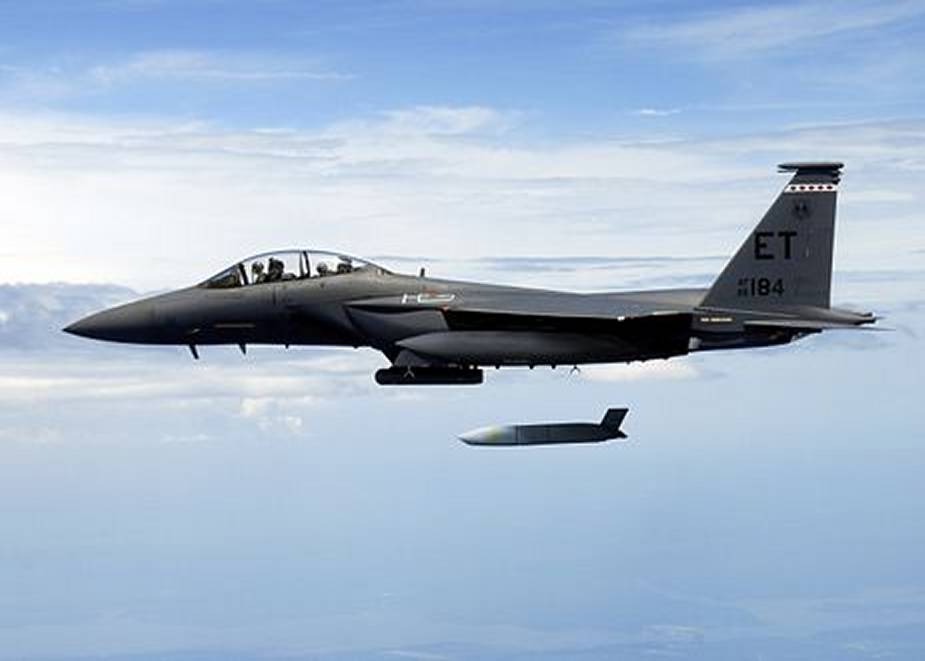Breaking news
US Navy plans to arm F/A-18E/F and F-35C with US Air Force JASSM-ER cruise missile.
According to Richard R. Burgess on SeaPower, the U.S. Navy’s 2022 budget includes funds for a cruise missile that will be new to the Navy but has been in production for the U.S. Air Force: the 2022 budget proposes a procurement of 25 AGM-158B Joint Air-to-Surface Standoff Missile Extended Range (JASSM-ER) cruise missiles.
Follow Air Recognition on Google News at this link

In late 2017, Lockheed Martin’s subsonic, turbofan-powered AGM-158B Joint Air-to-Surface Standoff Missile – Extended Range (JASSM-ER) cruise missile achieved full operational capability (FOC) on the Boeing F-15E Strike Eagle multirole strike fighter (Picture source: Lockheed Martin)
“The Joint Air-to-Surface Standoff Missile Extended Range (JASSM-ER)/AGM-158B will initially deploy on the F/A-18E/F Super Hornet. It will eventually be integrated on F-35C and future Navy strike fighter aircraft,” said Lt. Cmdr. Stephanie Turo, a Navy spokeswoman quoted by Richard R. Burgess. The Navy’s budget overview book said the JASSM-ER is being procured “to enhance long-range strike and offensive anti-surface warfare (OASuW) capability. In FY 2022 the JASSM program will award the 20th production lot in which the U.S. Navy, along with the U.S Air Force, will procure 25 assets for the first time.”
The Navy, along with the Air Force, both already operate the AGM-158C Long-Range Anti-Ship Missile (LRASM), which is a derivative of the JASSM. The Navy’s F/A-18E/F Super Hornet strike fighter is armed with the LRASM, which also is programmed to be deployed on the Navy’s P-8A Poseidon maritime patrol reconnaissance aircraft: in April 2021, the Navy awarded Boeing a contract to integrate the LRASM on the P-8A. Both the JASSM-ER and LRASM are built by Lockheed Martin, Richard R. Burgess recalls. “The Joint Air-to-Surface Standoff Missile Extended Range (JASSM-ER)/AGM-158B will initially deploy on the F/A-18E/F. It will eventually be integrated on F-35C and future Navy strike fighter aircraft,” said Lt. Cmdr. Stephanie Turo, a Navy spokeswoman.
The Navy’s budget overview book said the JASSM-ER is being procured “to enhance long-range strike and offensive anti-surface warfare (OASuW) capability. In FY 2022 the JASSM program will award the 20th production lot in which the U.S. Navy, along with the U.S Air Force, will procure 25 assets for the first time.”
The AGM-158 JASSM (Joint Air-to-Surface Standoff Missile) is a low observable standoff air-launched cruise missile developed by Lockheed Martin for the U.S. Armed Forces. It is a large, stealthy long-range weapon with a 1,000 pound (454 kg) armor-piercing warhead. It completed testing and entered service with the U.S. Air Force in 2009, and has entered foreign service in Australia, Finland, and Poland as of 2014. An extended range version of the missile, the AGM-158B JASSM-ER (Joint Air-to-Surface Standoff Missile-Extended Range), entered service in 2014. By September 2016, Lockheed Martin had delivered 2,000 total JASSMs comprising both variants to the USAF.
Operational history of the AGM-158 JASSM
The JASSM was first employed during the 14 April 2018 missile strikes against Syria during the Syrian Civil War. Two B-1 Lancers fired a total of 19 JASSMs as part of strikes against three Syrian government alleged chemical weapons targets. All 19 JASSM missiles were fired at the Barzah Research Center, which was destroyed in the strike. According to Russian state media, two missiles that failed to detonate were found by the Syrian Arab Army and transferred to Russia on 18 April for study - no evidence of this claim has been provided; initial reports had stated JASSM-ER missiles were used, but it was later clarified that baseline JASSM models were employed.
On 27 October 2019, at the end of the Barisha raid to capture or kill Abu Bakr al-Baghdadi, the then-leader of the Islamic State of Iraq and the Levant (ISIL) terror organization, a number of AGM-158B missiles were used to completely level the compound where the raid took place, marking the second time the missile has been used in combat.



















